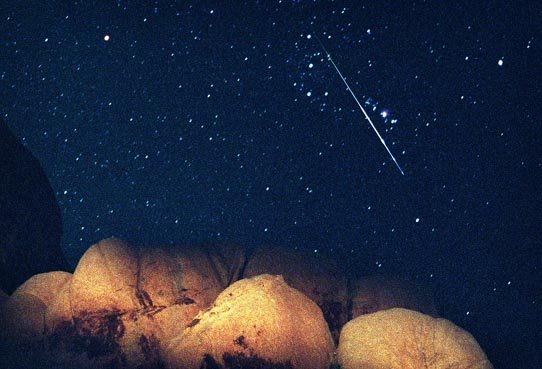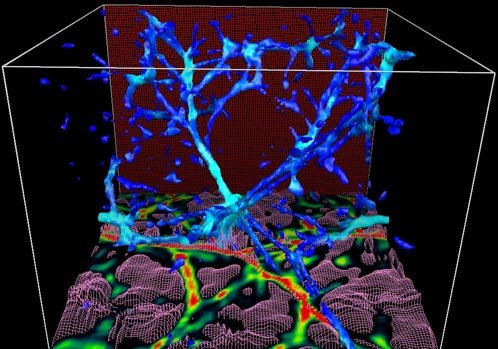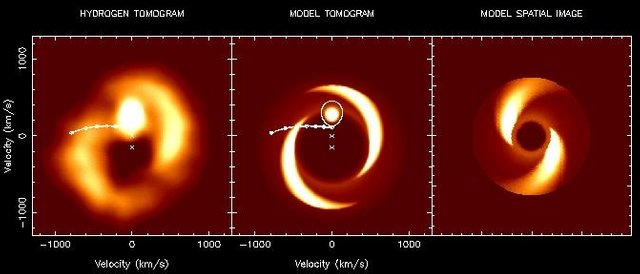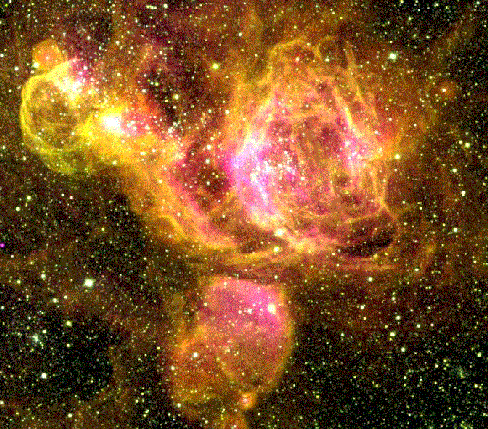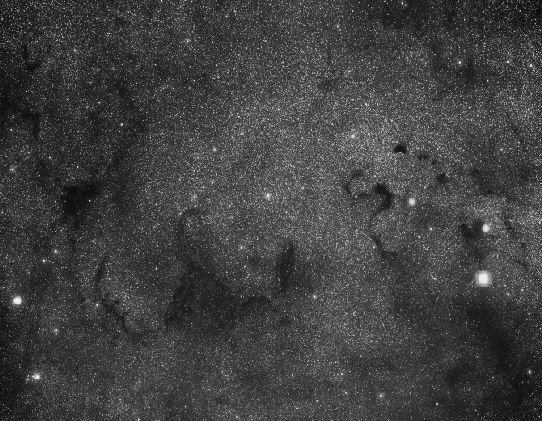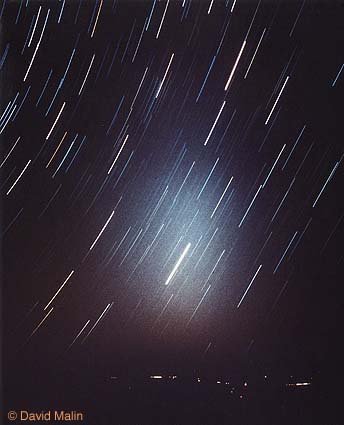NASA APOD #793-799
#793 Bright Meteor, Dark Sky August 20, 1997
“Has Orion the Hunter acquired a new weapon? If you turn your head sideways (counterclockwise) you might notice the familiar constellation of Orion, particularly the three consecutive bright stars that make up Orion's belt. But in addition to the stars that compose his sword, Orion appears to have added some sort of futuristic light-saber, possibly in an attempt to finally track down Taurus the Bull. Actually, the bright streak is a meteor from the Perseid Meteor Shower, a shower that put on an impressive display last Tuesday morning, when this photograph was taken. This meteor was likely a small icy pebble shed years ago from Comet Swift-Tuttle that evaporated as it entered Earth's atmosphere."
Copyright: W. Pacholka
#794 A Universe in a Box August 21, 1997
“Is this our universe? Possibly. It is one computerized guess of how gas in the universe was distributed billions of years ago, at redshift 3, when the universe was only a quarter of its present age. Using supercomputers at the National Center for Supercomputing Applications and assumptions about the composition and beginning of the universe, the GC3 team was able to reconstruct a hypothetical universe. A cube of this universe was cut out and displayed, with each side being about 8 million light years across. Color represents temperature of the hot gas. At the bottom a single slice through this cube is displayed, with helium abundance superposed with a wire mesh. The small structures appearing here give insight into the past and present structure of the intergalactic medium, the matter inhabiting the regions between galaxies and clusters of galaxies."
Copyright: Public domain
#795 IP Pegasi: Spiral Star August 22, 1997
“Spiral arms aren't just for galaxies. A hot disk of gas surrounding a compact white dwarf star in the constellation of Pegasus has recently been revealed to be imprinted with this dramatic pattern. The white dwarf is part of the interacting binary star system IP Pegasi and the disk of gas is an accretion disk formed of material lost from a companion star and falling toward the white dwarf. The disk itself is smaller than the Sun's diameter, so the spiral pattern can not be imaged directly by telescopes. Instead, the spiraling disk of gas is mapped over a series of observations using a spectroscopic technique known as doppler tomography. The left panel above shows a tomogram, the directly measured gas velocity map for the system. The relative brightness corresponds to the intensity of light emitted by Hydrogen gas moving at the indicated velocity. The position at the center of this panel represents the velocity of the binary system's center of mass. In the middle panel, a simple model velocity field consistent with the measurements is shown. At the right, the calculated position map of the IP Pegasi accretion disk reveals a striking two armed trailing spiral pattern."
Copyright: Public domain
#796 A Star Forming Region in the LMC August 23, 1997
“Stars sometimes form in colorful ways. Pictured above is a small region in the nearby LMC galaxy where stars are forming. After a star is born, it may do several things to energize its immediate neighborhood. It may develop a strong wind which pushes away nearby gas; it may be so hot and intense that emitted light boils away nearby dust and gas, and it may be so massive that it soon goes supernova and catapults its elements back to the interstellar medium. Astronomers study regions like this - named DEM192 - to better understand how these and other processes proceed. This picture is a composite of three separate photographs, each sensitive to only one specific color of light - a color that distinguishes a specific chemical element."
Copyright: Public domain
#797 The Snake Nebula in Ophiuchus August 24, 1997
“What slithers there? The dark winding lanes visible in part of the constellation Ophiuchus belong to the Snake Nebula. The Snake Nebula is a series of dark absorption clouds made up of Interstellar dust. Interstellar dust grains - composed predominantly of carbon - absorb visible starlight and reradiate much of it in the infrared. This absorption causes stars behind the clouds to be obscured from view, hence the appearance of starless voids on the sky."
Copyright: B. Wallis and R. Provin
#798 A Fisheye View of Comet Hale-Bopp August 25, 1997
“Thousands of stars, several constellations, a planet and a comet all graced the western horizon over Ujue, Spain just after sunset on April 4th, 1997. Because the picture was taken with a fisheye lens, much of the whole night sky is visible. Comet Hale-Bopp, with both tails blazing, appears right of center. The brightest star is Sirius near the edge, well to the left of the constellation Orion. The red star above the belt of Orion is Betelgeuse, while the red star near the center is Aldebaran, just to the left of the bright Pleaides star cluster. Many other interesting astronomical objects are visible, including zodiacal light, which is the diffuse triangular glow in the center. Even the planet Mercury appears just over the horizon."
Copyright: J. C. Casado
#799 Zodiacal Light August 26, 1997
“Sometimes the sky itself seems to glow. Usually, this means you are seeing a cloud reflecting sunlight or moonlight. If the glow appears as a faint band of light running across the whole sky, you are probably seeing the combined light from the billions of stars that compose our Milky Way Galaxy. But if the glow appears triangular and near the horizon, you might be seeing something called zodiacal light. Pictured above, zodiacal light is just sunlight reflected by tiny dust particles orbiting in our Solar System. Many of these particles were ejected by comets. Zodiacal light is easiest to see in September and October just before sunrise from a very dark location."
Copyright: AAOAATB
Upvote! Resteem! Comment! As you like it! Thank you for attention!
